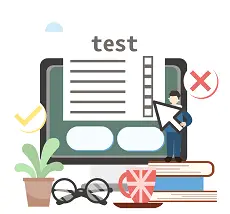“Please let me know your thoughts’ is a very commonly used term in English that you’ll hear not only in board meetings but also in real-life group discussions. However, most commonly it is used in formal emails as a way to indicate your willingness to hear someone’s opinion on a specific topic.
But, it isn’t the only statement that can be used to serve this purpose. There are several alternatives to “let me know your thoughts” that we’ll look at in this article.
Is It Correct to Say “Please Let Me Know Your Thoughts”?
Yes, it is correct to say “Please let me know your thoughts.” It is a polite and common way to ask someone for their opinions or feedback on a certain topic or situation. It is a way to show that you value and respect their input. However, there might be other alternative ways to phrase the request that could be more engaging or effective depending on the context. Below you will find these other alternative phrases and examples in which situations you can use them.

Please Let Me Know Your Thoughts: Some Examples
Here are some situations in which you can use this term:
You email a mockup for your client to see and review and require their feedback in order to finalize the project. You can add ‘please let me know your thoughts about the design’ to indicate you are waiting on their feedback to move ahead.
• You’re the HR head and you want to propose policy changes to your boss. You write an email covering your suggested changes and the impact they may have on productivity. In the end, you can add ‘please let me know your thoughts about this change’ to indicate you need your boss’s feedback in order to implement these changes.
• The term does the job well but it isn’t the best option as “please let me know your thoughts” is too common and overused, which may result in some people ignoring it. Also, it may end up sounding too aggressive in some situations. Moreover, some experts believe it isn’t a classy way to end an email or conversation. This is why you need to use a “please let me know your thoughts” alternative.
Here are some of the most popular options:
1. Please respond when you can
This “please let me know your thoughts” alternative tells the other person you want their response. It does the same job as “please let me know your thoughts” and gives the other person the option to respond according to their schedule.
Though helpful, this option may not be suitable in situations when you need an urgent response.
Example:
• You send an email explaining the latest changes to your marketing strategy and the result these changes have generated. You can add “please respond when you can” in the end to let the recipient know there isn’t much to add but they can respond when they get a chance t.
2. Feel free to share what you think
This sentence indicates that the other party has the option to share their feedback, which you may consider, but it isn’t mandatory.
Example:
• You’re the HR manager who sends an email to all employees announcing a special get-together next month. In the end, you can add “feel free to share what you think” to indicate you’re interested in feedback but may not change your plan based on it.
3. Any Thoughts?
This phrase is suitable for semi-formal conversations. It can be used in situations where you share your opinion on something and give the other person an opportunity to share theirs. It can be used when you’re talking to your colleagues or when the conversation is not very formal.
Example:
• You discuss the dress code with your friends and give a suggestion adding ‘any thoughts?” to let them know their thoughts are welcomed.
4. Is there anything you’d like to add?
This approach can be great when you’re working in a team and need feedback from other team members. It shows that you have the answer but you’d like to take input from others.
Example:
• You prepare the menu for your annual dinner and send it to the relevant department for their approval adding “is there anything you’d like to add?’ indicating they can suggest changes to the menu.
5. I’ll appreciate some feedback
This indicates you’d like to have their feedback; however, this option may not be suitable when feedback or opinion is mandatory as it gives the other person the choice to reply. They may choose not to reply as it doesn’t show urgency.
Example:
• You create a presentation to share with your team and decide to seek the opinion of a senior colleague. You can send an email with the presentation adding “I’ll appreciate some feedback” indicating you value their opinion.
6. Should you have any questions, please feel free to contact me
This statement is used in situations where there may be some confusion. It’s typically used when you’re talking to someone who isn’t fully aware of your business or the topic you’re discussing.
Example:
• You send a quotation to a client and add “should you have any questions, please feel free to contact me” indicating that you’ll be there to guide them.
7. Waiting for your input
This statement shows your eagerness to listen to what others have to offer. The word ‘input’ indicates you want their critical opinion on something.
Example:
• You have to write a business letter but you’re not sure what to include in it. You can write to a colleague for help and add ‘waiting for your input’ to indicate you want their suggestions.
8. Waiting for your prompt response
The word prompt indicates that you’d like a quick reply but it doesn’t put any pressure on the recipient by mentioning a specific deadline. This “please let me know your thoughts” alternative can be used when you are in a hurry but you don’t want to mention a date. It is typically suitable in situations when the other person is aware of the deadline.
Example:
• You send a list of shortlisted candidates for interview next week to your boss and ask for their feedback adding “waiting for your prompt response”. They know how urgent it is to fill the vacant seat and will respond accordingly.
9. Please get back to me by “date”
This option is used when there’s an urgency and you’d like to receive a reply within a given time frame.
Example:
• You’ve requested a leave of absence from 9th Jan to 15 Jan and would like to hear back by 1st Jan so you can have enough time to plan.
10. I look forward to hearing from you
Last on the list is “I look forward to hearing from you”, which is suitable in situations where you are hopeful of a response.
Example:
• You can use this phrase when you send your resume for a job interview. It shows you’re eagerly waiting to get a response.









